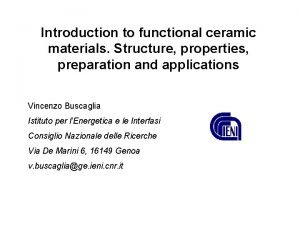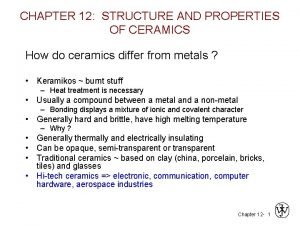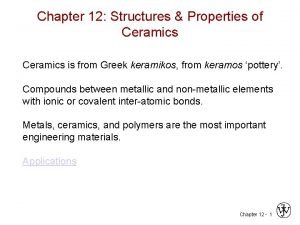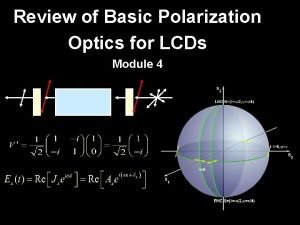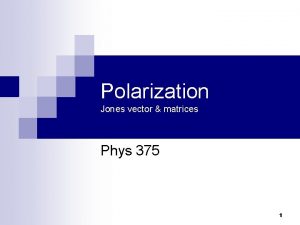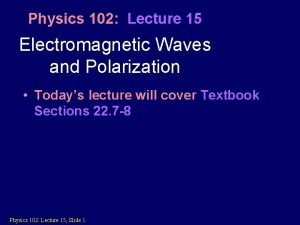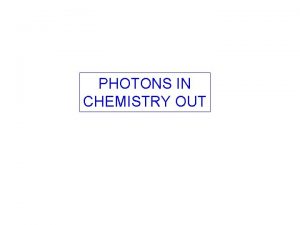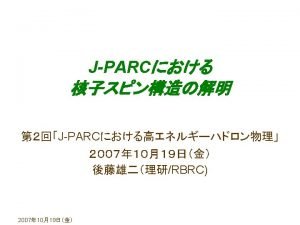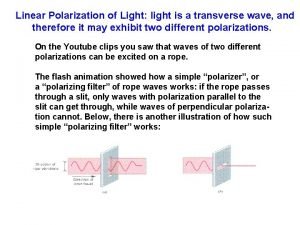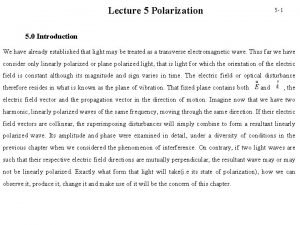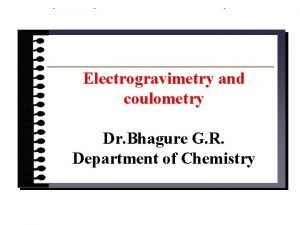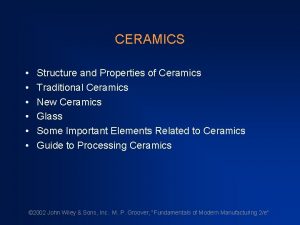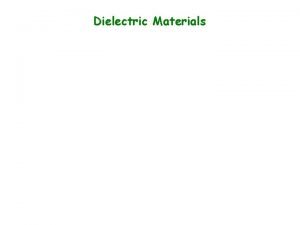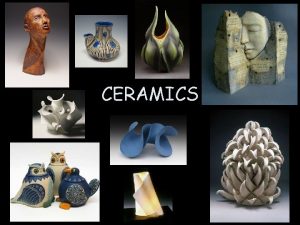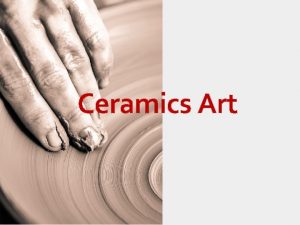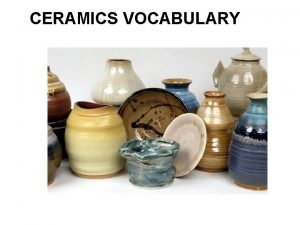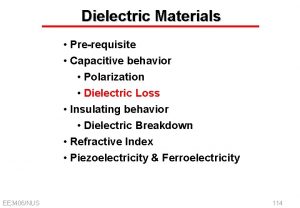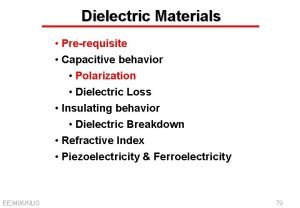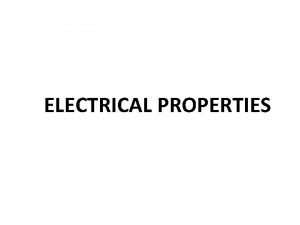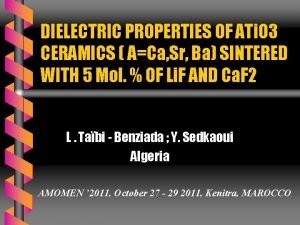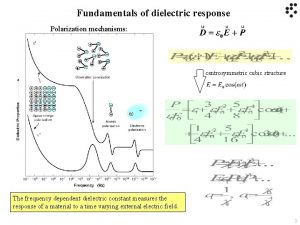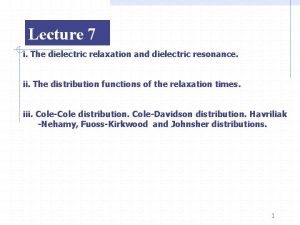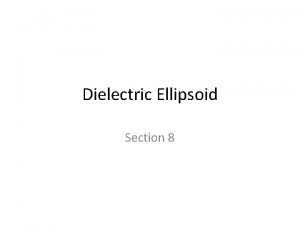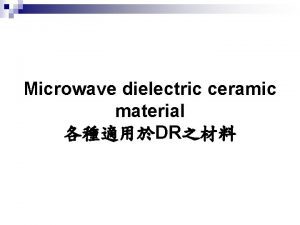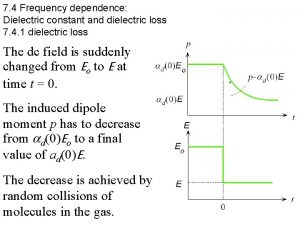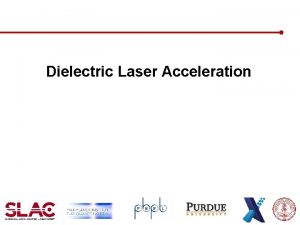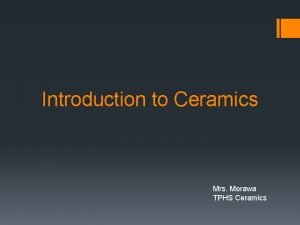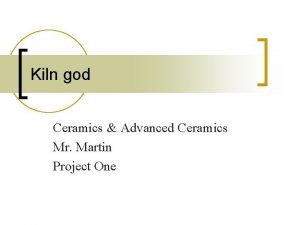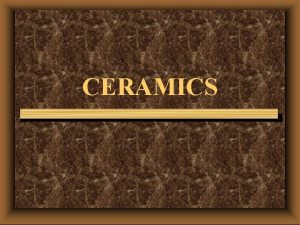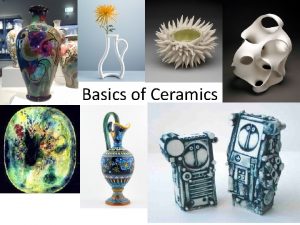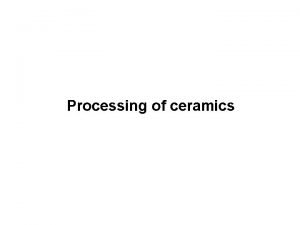Dielectric properties of ceramics Polarization mechanisms After application

























- Slides: 25

Dielectric properties of ceramics

Polarization mechanisms After application of an electric field, the center of gravity of positive and negative charges does not correspond anymore f Electronic polarization: deformation of the electronic shell. Electronic Atomic or ionic polarization: displacement of negative and positive ions in relation to one another Ionic Dipolar Orientation Space charge or diffusional Dipolar and orientation polarization • Alignement of dipolar molecules in a liquid • Spontaneous alignement of dipoles in a polar solid (ferroelectricity) • Ion jump polarization occurs when two or more lattice positions are available for a ion or lattice defect • Reorientation of dipolar defects Space charge polarization occurs when charges accumulate at interfaces: composite materials, insulating surface skin, electrode polarization effects

Polarization, capacitance and dielectric constant h A p p Dipoles and surface charges in a polarized dielectric Dipole moment Polarization Dielectric displacement (dipole moment per unit volume) ( 0 is the vacuum permittivity) Surface charge density For a linear dielectric Capacitance Permittivity Relative permittivity (or dielectric constant) ( e is the electric susceptibility)

Polarization, capacitance and dielectric constant Polarizability ( ) (induced dipole moment per unit field) Clausius-Mosotti relationship is the local field constant More generally “Polarization catastroph” If Electronic polarizabilities are rather independent of crystal environment and high frequency dielectric constant can be predicted than The local field produced by polarization can increase more rapidly than the restoring force thus stabilizing the polarization further possibility of spontaneous polarization (ferroelectric instability) for a linear dielectric

Dielectric losses IC: 90° in advance of U Current Angular frequency =2 f = 2 /T Il: in phase with U Voltage Ideal capacitor: 90° phase difference between I and U, no dissipation Real capacitor: <90° phase difference between I and U. Ic: charging current (capacitative component) Il: loss current, dissipative comp. , power loss Power dissipated per unit time Dissipated power density tan : “dissipation factor” or “loss tangent” rtan : “loss factor” By analogy with dc current Dielectric or ac conductivity

Complex permittivity The behaviour of ac circuits can be conveniently analysed using complex quantities Real part Imaginary part Im Complex sinusoidal voltage 90° in advance Re Vacuum capacitor Capacitor with a lossy dielectric Ic Il By analogy with Ohm’s law: I =U/R or J = E

Resonance effects in dielectrics E Charged particle in a harmonic potential well Equation of motion 0: natural vibration frequency : damping factor Q: charge m: mass E: local field This behaviour is generally observed for the electronic and ionic polarization processes, where the charges/dipoles move around the equilibrium positions and final polarization is almost instantaneously achieved. Resonant frequencies are of the order of 1013 and 1015 s -1, respectively, and fall in the optical range.

Relaxation effects in dielectrics – migration & orientation polarization Dipolar and space charge polarization is generally accompanied by the diffusional movement of charge and dipoles over several atomic distances and surmounting energy barriers of different high. These polarization processes are relatively slow and strongly temperature dependent (thermally activated). If the transient polarization is described by a simple exponential function, the dipolar relaxation is described by the Debye equation. Reorientation of dipolar defects (defects pairs) Fe Ti Debye relaxation V O Electrostatic potential in a glass or defective oxide Relaxation time

’r ’r, s Debye relaxation ’r, ’’r Frequency dispersion region ½( ’r, s- ’r, ) ’’r << r: ions follow the field low losses =1 Maximum loss occurs when the field frequency is equal to the jump frequency , =1 >> r: ions do not jump low losses ( ’r, s- ’r, )/ Ea takes values typical of ionic conduction processes (0. 7 e. V), giving a loss peak in the range 103 – 106 Hz.

Relaxation effects in dielectrics – migration polarization Debye relaxation holds when the transient polarization is described by a simple exponential with a single relaxation time. In most materials, including single crystals, a distribution of relaxation times exists and permittivity dispersion is observed over a wider frequency range. This is related to variations of the ionic environment and thermal fluctuations with distance and existence of lattice defects. The extreme case is represented by glasses and amorphous materials. Dielectric relaxation is better described by the equation (Cole&Cole) which takes into account that the motion of ions responsible for relaxation can be of cooperative type. = 0. 2 -0. 3 for glasses. = 1: Debye Dielectric dispersion in silicate glasses


Relaxation effects in dielectrics – effect of temperature and frequency Electronic and ionic polarization resonance occurs at f>1010 Hz which is above the limit of normal uses. The effect of temperature is small. Contribution from ion and defect migration as well as dc conductivity determine a sharp rise of permittivity with increasing temperature and decreasing frequency. Increasing concentration of charge carriers in turn leads to space charge effects. Dielectric constant of single crystal Al 2 O 3 Dielectric constant of soda-lime silica glass

Relaxation effects in dielectrics - Space charge polarization Polycrystalline and polyphase ceramics exhibit interface or space charge polarization (also called Maxwell-Wagner polarization) arising from different conductivity of the various phases. The most important occurrence of this phenomenon is in semiconducting ceramic oxides with resistive (oxidized) grain boundaries (magnetic ferrites, titanates, niobates) , in which the low frequency permittivity can be several orders of magnitude higher than the high frequency dielectric constant and is dominated by the contribution of grain boundaries. (1) (2) d 1 d 2 Brick-wall model If x = d 1/d 2 << 1, 1 >> 2 and ’r, 1= ’r, 2

Special relationships involving permittivity RF & MW IR UV-Vis At optical frequencies, electronic polarization is the main contribution to permittivity. If n is the index of refraction Ba. Ti. O 3 single crystal For ferroelectric materials in the paraelectric regime (T > TC) C: Curie constant T 0: Curie-Weiss temperature TC =120°C

Properties and applications of dielectric ceramics of commercial interest

Dielectric losses For alumina ceramics, = 10 -12 ohm cm, ’r = 10, tan = 2 x 10 -4 at 1 k. Hz MW region

Properties of ceramics with low permittivity and low losses Typical properties of dielectric ceramics Material Applications Steatite Porcelain insulators Cordierite Applications requiring good thermal shock resistance. Supports for high-power wire-wound resistors. Alumina Best compromise of dielectric losses, high mechanical strength, high thermal conductivity. Reliable metal-ceramic joining technoloy (Moly. Mn) available. Beryllia Good properties, very high thermal conductivity, expensive and difficult processing. Insulating parts in high-power electromagnetic energy generation (klynstrons and magnetotrons). Al. N High thermal conductivity and TEC close to that of silicon. Substrate for power electronic circuits and chips. Glass & glass-ceramics Cheap material and easy processing. Low thermal conductivity


Properties of ceramics with low permittivity and low losses Typical properties of alumina ceramics Spark plugs Microstructure of alumina ceramics 99. 9% Al 2 O 3 96% Al 2 O 3 Tan of 99. 9% alumina ceramics Insulating parts in high-power electromagnetic generation. Windows for high-power microwave generators. Substrates for electronic circuits. Cheap packaging.

Electronic substrates and chip packaging



Power electronic substrates The role of the substrate in power electronics is to provide the interconnections to form an electric circuit (like a printed circuit board), and to cool the components. Compared to materials and techniques used in lower power microelectronics, these substrates must carry higher currents and provide a higher voltage isolation (up to several thousand volts). They also must operate over a wide temperature range (up to 150 or 200°C). Direct bonded copper (DBC) substrates are commonly used in power modules, because of their very good thermal conductivity. They are composed of a ceramic tile (commonly alumina) with a sheet of copper bonded to one or both sides by a high-temperature oxidation process. The top copper layer can be preformed prior to firing or chemically etched using printed circuit board technology to form an electrical circuit, while the bottom copper layer is usually kept plain. The substrate is attached to a heat spreader by soldering the bottom copper layer to it. Ceramic materials used in DBC include Al 2 O 3, Al. N and Be. O.

Dual in-line package (DIP) Ceramic (EPROM) Plastic Ceramic (Intel 8080) Pin grid array packaging (PGA) Celeron (top) Pentium (bottom) Socket PGA (AMD)

 After me after me after me
After me after me after me If any man comes after me
If any man comes after me Dielectric properties of food
Dielectric properties of food Greek beads keramos
Greek beads keramos Structure and properties of ceramics
Structure and properties of ceramics Rcation/ranion
Rcation/ranion Module 79 ap psychology
Module 79 ap psychology Deindividuation
Deindividuation Dispositional attribution example
Dispositional attribution example Charge by polarization
Charge by polarization Group polarization example
Group polarization example Polarization psychology
Polarization psychology Group think vs group polarization
Group think vs group polarization Group polarization vs groupthink
Group polarization vs groupthink Group polarization example
Group polarization example Depolarization vs polarization
Depolarization vs polarization Polarization ellipse equation
Polarization ellipse equation Quarter wave plate jones matrix
Quarter wave plate jones matrix Group polarization example
Group polarization example Polarization in physics
Polarization in physics Polarization in chemistry
Polarization in chemistry Depolarization vs polarization
Depolarization vs polarization Linear polarization
Linear polarization Light polarization equation
Light polarization equation Groupthink vs. group polarization
Groupthink vs. group polarization Electrogravimetry without potential control
Electrogravimetry without potential control



